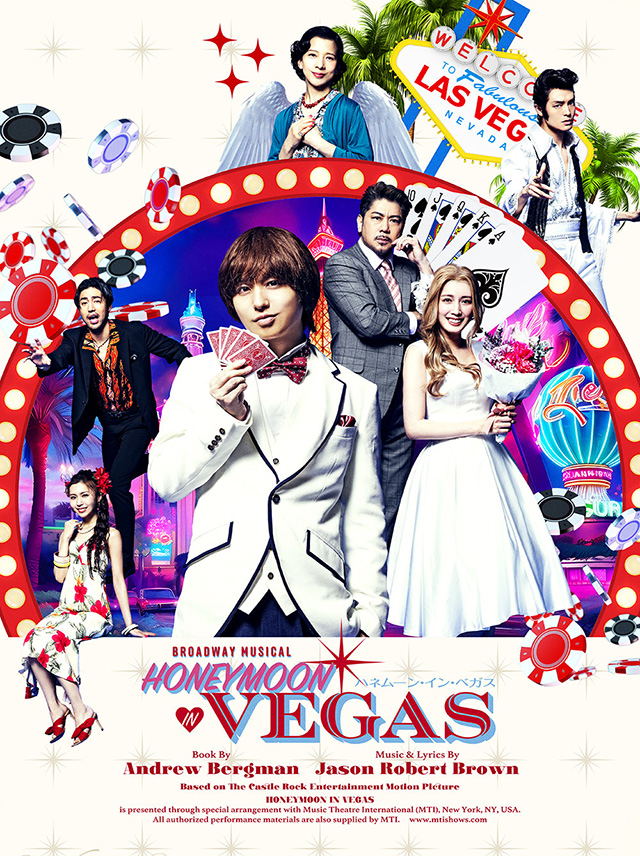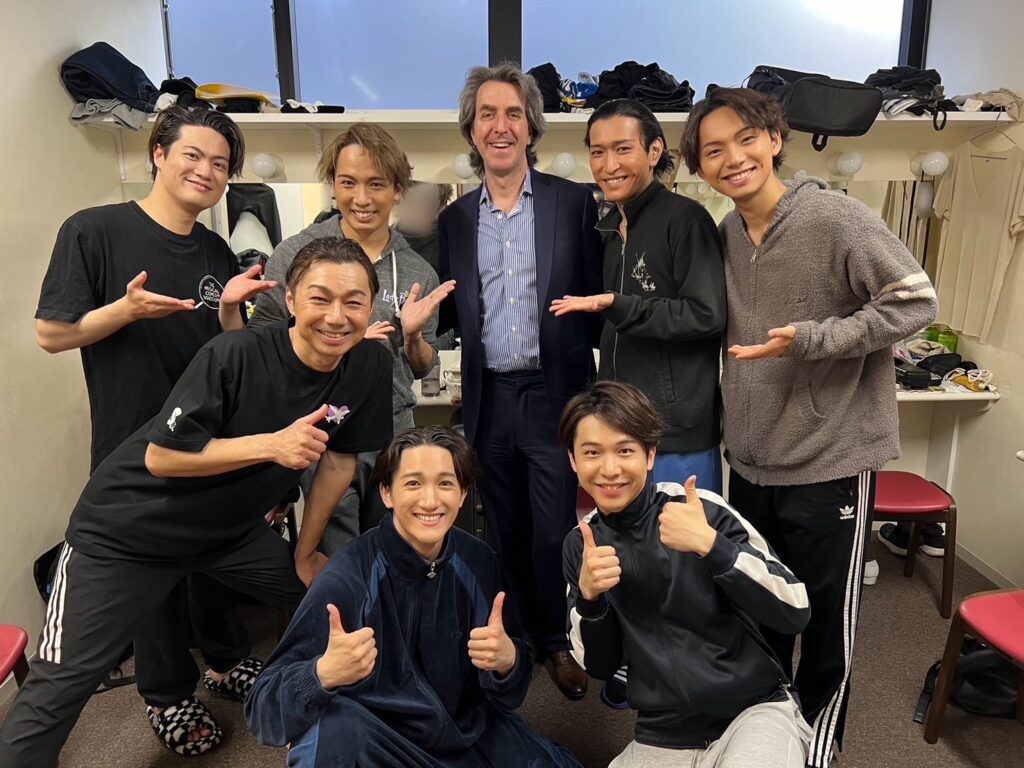Posted on April 23, 2024 at 7:18 pm

Some things involving Hal Prince really only make sense in the context of Hal Prince, so I won’t take up your time attempting to explain why we did our first production of Prince of Broadway in Tokyo, but it’s true, we did, in 2015.
(Here’s a photo of Reon Yuzuki coming down the steps for the Follies sequence.)

I’d never heard of a theater on the top floor of a department store before, but that’s what the Theater Orb was, an enormous facility with 2000 seats and a stage the size of the Metropolitan Opera (and an orchestra pit to match), with nine floors of cosmetics, clothing, shoes and jewelry below it. And, as is typical of Japanese department stores, a basement level filled with magnificent, beautiful, endlessly distracting food.
We spent two weeks in tech at that theater, long boring days where the music department mostly idled in the dark while Hal and Stro perfected set transitions and lights and fussed with spacing. Tech makes me depressed and anxious, as anyone who’s been through it with me can attest, so any time I could get away with it, I would wander off and explore that magical basement, with its gorgeously curated displays of chocolate and pastry and tea and impossibly perfect produce. One afternoon, I texted upstairs to the rest of the music department that my life had been changed. At a fairly unassuming counter in the corner of the cellar, I had found the world’s best soft-serve ice cream.
I love all ice cream, but I have a particular, almost Proustian obsession with soft-serve. The dopey Mister Softee jingle is the only New York City street noise that actually brings me joy. You might go to the beach for the waves, but I go for the Good Humor trucks. Anywhere in the world, no matter what the temperature or time of day, if I see someone walking down the street absentmindedly licking a turban-shaped mass of dairy, I’m gonna start looking for where they got it. And look, I acknowledge that most soft-serve ice cream isn’t in fact very good – It’s sort of a bland and mechanical echo of something much better, extruded into a cone that tastes and feels like styrofoam. But, like some of my favorite musicals and prog-rock albums, it doesn’t need to be good for me to love it. It just needs to be what it is: the delicious freedom of a summer evening, dripping on to my hand.
But THIS ice cream in the basement of Shibuya Hikarie… To begin with, there was nothing Japanese about it. The little counter where it was sold is one of several outposts of a hyper-bougie Belgian chocolatier named Pierre Marcolini. I don’t know if all of their locations have the soft-serve machines. (Thus far, Marcolini has not opened a shop in the US.) Compared to what I guess I’ll call “normal” soft-serve, the Marcolini ice cream was amazingly dense, almost like a mousse. The color told you something as well – several shades darker than any chocolate soft-serve you’ve had before, like a ganache in a cone. But for all that density and richness, it wasn’t heavy – it still had an essential lightness, refreshing rather than the kind of enervating overload of eating, say, a spoonful of cake frosting. And the cone! A perfectly crisp cookie, not too thick, not too sweet, which balanced the chocolate exactly so that every bite felt complete. The point is, I walked down to the basement and ate this ice cream and suddenly, the world was new. I dragged the rest of the music team down nine flights of escalators and converted them all. Nine years later, we all still talk about that soft-serve.
(This is the evidence, a photo of that music team in the basement of Shibuya Hikarie nine years ago: pianist James Sampliner, drummer Jamie Eblen, music associate Haley Bennett and conductor Fred Lassen.)

And nine years later, for the first time since then, I went back to Tokyo this week. In February of this year, while I was in tech for The Connector, I got the very surprising news that the Japanese premiere of Honeymoon In Vegas was going to take place this spring in a full-scale, bells-and-whistles production at a 1300-seat theater in Tokyo (and then Osaka a month later). The producer, who had previously mounted The Last Five Years several times in Japan to great success, invited me to come over and see the show. The timing was propitious – I could go after I’d finished The Connector and my concert at the Palladium but before I started rehearsals for Midnight In The Garden of Good and Evil – and it all sounded so unlikely that I had to say yes.

I don’t think of myself as being a particularly “American” writer, but then I go see my shows in other countries and I realize how mystifying many of the behaviors and cultural references must be. Honeymoon In Vegas, which I would have thought was one of the more broadly comprehensible shows in my canon, turns out to require some very specific context. Mount Kisco vs Brooklyn. Foxwoods, J-Date, Go Blue! Planes making connections in Atlanta. On top of which, the rhythms of the English language are very different from Japanese, which affects not just the lyrics but the way the dialogue lands. A joke may not work if you have to change the sentence structure, and when you have jokes as good as Andy Bergman’s, that can be a crisis. So I knew that going to see this show in Japanese with a Japanese audience was going to be a little bit surreal.
Having said that, going to see ANY big musical in Japan can be a bewildering experience for a Westerner. A lot of things will seem familiar – you pick up your tickets at the box office, you go to your assigned seat, there’s a proscenium, there’s lighting and sound equipment and stage managers and souvenir programs and all the standard accoutrements of professional commercial theater. But in the details, things get strange.
For one thing, the time on the ticket is the time the show starts. To the second. I’ve been doing shows for over thirty years now, and every theater where I’ve worked operates on the theory that an 8:00 show really starts some time around 8:05, maybe even 8:07. In Tokyo, that would be a great embarrassment. There is actually a clock on the wall of every theater, and at one minute before showtime, the entire audience stops talking and waits silently for the show to begin. It’s eerie. Intermission is the same thing – it’s twenty minutes, and that’s exactly how long it takes.
Speaking of the starting time: it’s not 8 pm. Matinees start at 1 pm and evening shows start at 6 pm. And there are generally more matinees than evening shows. There’s a very specific cultural reason for this, and you might be able to figure it out if you look around at the audience and notice what’s missing.
There are no men. 99% of the ticket-buyers for musicals in Japan are women. Any gender-conforming male in the house is probably a relative of someone in the company. And in Japan, women are expected to be home with their families at the end of the day, so the majority of performances happen before sunset. I’ll leave it to someone with a more complete understanding of Japanese society to explain why attending the theater is such a heavily gendered activity, but it’s undeniable and it’s kind of a problem.
One other thing that catches me off guard during a show: there’s a lot of clapping along. Pretty much as soon as any pop or rock groove gets going, one thousand people will simultaneously start clapping (on 2 & 4, thank goodness), and then stop just as abruptly when the tempo shifts. I think that means they like it, but I can’t be entirely sure.
This production of Honeymoon In Vegas has one other unusual element, which sort of exacerbates all the other things I just listed. The star of the show, playing the role of Jack (originated in the film by Nicolas Cage and on Broadway by Rob McClure), is Kei Inoo, a 34-year-old pop idol best known as a member of the boy band Hey! Say! Jump!, for which he has been playing keyboards, singing and dancing since he was seventeen.
Getting Kei to star in the show was a pretty big coup, and it essentially ensured that the entire run would be sold out, with tickets in high demand (yay!). But Kei’s fans are not necessarily musical theater people – they’re there to see a pop star live and up close. So if you come to see the show because you want to see, you know, the show, you have to overlook the giggling and sighing that accompanies Kei’s every entrance, and resign yourself to the fact that the rest of the company – excellent musical theater actors all – are performing in a kind of vacuum.
But the cast is great, Kei included, and the band is truly top-notch, swinging with ease and playing with obvious relish. What I love most about Honeymoon In Vegas is how joyful it is, and that joy translates just fine.




I ended up watching the show twice, and then, the next morning, the producer picked me up at my hotel and took me to see authentic Japanese kabuki for the first time. I had expected kabuki to be much weirder than it turns out to be, although it may be that the ten years I’ve spent studying Chinese opera for Farewell My Concubine prepared me. But it certainly does move slowly, although the effect is often uniquely beautiful.
After kabuki, I got to eat some sensational sushi in Ginza, and then I was about to head back to my hotel to pack for the trip home when I realized there was something I needed to do.



I’m delighted to inform you that Pierre Marcolini still has a counter in the basement of Shibuya Hikarie, and the soft-serve is just as wonderful as I remembered.

No comments yet. You should be kind and add one!
The comments are closed.